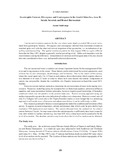Search
Now showing items 1-10 of 11
Trace Metal Concentrations and Distributions in Sea Water of the South China Sea, Area II: Sabah, Sarawak and Brunei Darussalam
(Training Department, Southeast Asian Fisheries Development Center, 1999)
Water samples off Sabah, Sarawak and Brunei Darussalam were collected during July–August 1996 and May 1997 and analyzed for dissolved and particulate cadmium, copper, iron, lead and nickel. Dissolved metals were coprecipitated ...
Distribution and Composition of Photosynthetic Pigments in the South China Sea, Area II: Sabah, Sarawak and Brunei Darussalam Waters
(Training Department, Southeast Asian Fisheries Development Center, 1999)
Depth integrated biomass of phytoplankton in the southern part of the South China Sea off Sarawak, Brunei Darussalam and Sabah in July 1996 and May 1997 was represented by in situ fluorescence. The total biomass in the ...
Primary Production Determination in the South China Sea, Area II: Sabah, Sarawak and Brunei Darussalam Waters
(Training Department, Southeast Asian Fisheries Development Center, 1999)
Primary production in the South China Sea, off Sabah, Sarawak and Brunei Darussalam was determined from in situ fluorescence, light intensity and the uptake of radioactive carbon incubation on the MV.SEAFDEC cruise in ...
Biogeochemical Implications of Dissolved Trace Metal Concentration and Distribution in the South China Sea, Area 1: Gulf of Thailand and East Coast of Peninsular Malaysia
(Training Department, Southeast Asian Fisheries Development Center, 1999)
Dissolved cadmium, copper, iron, lead and nickel in seawater at different depths were analyzed using the cobalt-APDC coprecipitation technique. The concentrations found were low and within the range found in natural seawater ...
Numerical Simulations of the Net Current in the Gulf of Thailand under Different Monsoon Regimes
(Training Department, Southeast Asian Fisheries Development Center, 1999)
Net circulation in the three layers in the Gulf of Thailand 0-10 m, 10-40 m and >40 m were simulated by a hydrological model using tri-monthly average of observed temperature, salinity, depth and wind. Prevailing monsoon ...
Petroleum Hydrocarbon in Seawater and Some Sediments of the South China Sea, area I: Gulf of Thailand and East Coast of Peninsular Malaysia
(Training Department, Southeast Asian Fisheries Development Center, 1999)
Petroleum hydrocarbon in water samples and sediments collected during the Pre-Southwest Monsoon Cruise in the Gulf of Thailand and Eastern Peninsular Malaysia in April-May 1996 point out that land-based and sea-based sources ...
Physical Characteristics of Watermass in the South China Sea, Area I: Gulf of Thailand and East Coast of Peninsular Malaysia
(Training Department, Southeast Asian Fisheries Development Center, 1999)
Our study provides new information on the physical characteristics of watermass in the South China Sea. We analyzed the temperature, salinity and density profiles to determine the effect of the NE monsoon on the variability ...
Dissolved Oxygen and Carbonate-carbon Dioxide in the Sea Water of the South China Sea, Area I: Gulf of Thailand and East Coast of Peninsular Malaysia
(Training Department, Southeast Asian Fisheries Development Center, 1999)
Dissolved oxygen and carbonate system in seawater in the Gulf of Thailand and the east coast of Peninsular Malaysian September 1995 and April-May 1996 were determined. It was found that surface water was well in equilibrium ...
Physical Characteristics of Watermass in the South China Sea, Area II: Sarawak, Sabah and Brunei Darussalam Waters
(Training Department, Southeast Asian Fisheries Development Center, 1999)
This study provides new information on the physical characteristics of water masses in Sabah and Sarawak waters. The aim was to determine the effect of Southwest (SW) monsoon on the variability of water masses, in Sabah ...
Geostrophic Current, Divergence and Convergence in the South China Sea, Area II: Sabah, Sarawak and Brunei Darussalam
(Training Department, Southeast Asian Fisheries Development Center, 1999)
Current and circulation patterns for the area where water depth exceeded 500 m were calculated from geostrophic balance. Divergence and convergence inferred from horizontal circulation matched quite well with the observed ...










